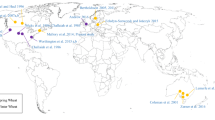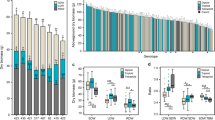Summary
The presence of significant levels of intergenotypic competition amongst barley (Hordeum vulgare) genotypes has profound consequences for barley breeding programmes. Breeding programmes based on the pedigree system attempt to identify genotypes in genetically heterogeneous populations but the elite genotypes are grown in monoculture. Thus, to attain varietal status genotypes produced by this breeding strategy must perform well in mixtures as well as in pure stands. The effectiveness of early generation selection may be hampered by intergenotypic competition. To examine this problem in spring barley, a modified substitution experiment (Mather and Caligari 1981, 1983) was used and included genotypes sampled from a random set of inbred lines generated without conscious selection. This approach to the investigation of competitive effects in barley indicated the presence of significant levels of intergenotypic competition for a range of agronomic characters. The analyses allowed a distinction to be made between aggression (a) and response (r) with the component r displaying greater variation than a. The lack of correlation in the distribution of a and r suggested that they were under separate genetic control and hence adjustable by selection. The implications of these results for barley improvement, the use of varietal mixtures and mixed cropping are discussed.
Similar content being viewed by others
References
Baker RJ, Briggs KG (1984) Comparison of grain yield of uniblends and biblends of 10 spring barley cultivars. Crop Sci 24:85–87
Brim CA (1966) A modified pedigree method of selection in soya beans. Crop Sci 6:220
Caligari PDS (1980) Competitive interactions in Drosophila melanogoster. 1. Monocultures. Heredity 45:219–231
Mather K, Caligari PDS (1981) Competitive interactions in Drosophila melanogoster. 2. Measurement of competition. Heredity 46:239–254
Mather K, Caligari PDS (1983) Pressure and response in competitive interactions. Heredity 51:435–454
Mather K, Hill J, Caligari PDS (1982) Analysis of competitive ability among genotypes of perennial ryegrass. Heredity 48:421–434
Spitters CJT (1979) Competition and its consequences for selection in barley breeding. Centre for Agricultural Publishing and Documentation, Wageningen (Doctoral thesis, Wageningen)
Valentine J (1979) The effect of competition and method of sowing on the efficiency of single plant selection for grain yield, yield components and other characters of spring barley. Z Pflanzenzucht 83:193–204
Valentine J (1982) Variation in monoculture and in mixture for grain yield and other characters in spring barley. Ann Appl Biol 101:127–141
Wolfe MS (1978) Some practical implications of the use of cereal variety mixtures. In: Scott PR, Bainbridge A (eds) Plant disease epidemiology. Blackwell, Oxford, 201–207
Author information
Authors and Affiliations
Additional information
Communicated by A. R. Hallauer
Rights and permissions
About this article
Cite this article
Powell, W., Caligari, P.D.S., Goudappel, P.H. et al. Competitive effects in monocultures and mixtures of spring barley (Hordeum vulgare). Theoret. Appl. Genetics 71, 443–450 (1985). https://doi.org/10.1007/BF00251185
Accepted:
Issue Date:
DOI: https://doi.org/10.1007/BF00251185




